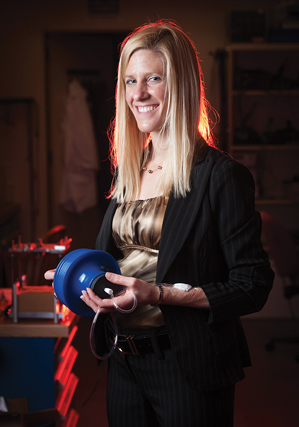Building a Better Wound Healer
Before earning a doctorate at MIT, Danielle Zurovcik, SM ’07, PhD ’12, had never designed or developed a medical device. But her experience in the Precision Engineering Research Group, led by Professor Alex Slocum ’82, SM ’83, PhD ’85, led her to develop a simplified negative-pressure wound therapy device that would later become known as the Wound-Pump.

“I realized that I was passionate about medical devices. I liked the Wound-Pump because we were able to put it on patients faster than a technology that was highly invasive,” she says.
A negative-pressure wound therapy device applies a vacuum dressing to the wound to drain fluid and increase blood flow. It also stresses the cells, which causes them to divide faster and accelerates the healing process. The device currently on the market is expensive and needs electricity to operate; Zurovcik’s Wound-Pump costs less than $3 to make and is entirely mechanical, requiring no electricity.
As part of her D-Lab Scale-Ups fellowship, Zurovcik took her device into the field, putting it to use in Haiti after the earthquake there as well as testing it during a study in Rwanda. After witnessing its successful application, she realized that the device could solve an immediate and critical need.
Zurovcik founded and now serves as CEO of Worldwide Innovative Healthcare (WiCare), a company that develops effective and inexpensive medical devices. WiCare’s goal is to make high-quality health care available to remote or impoverished areas of the world. The Wound-Pump is the company’s first product.
While starting a company isn’t an easy task, Zurovcik draws inspiration and motivation from the many patients the Wound-Pump has already helped.”Whenever you’re working all hours of the night and you’re like, ‘What am I doing this for?’ You have to think of those small cases that are making you move forward,” she says.
For aspiring entrepreneurs, she offers this piece of advice: “Be true to yourself. Because you’re going to have to put a lot of time into it, so you should put a lot of time into what you’re comfortable with and what you love.”
Keep Reading
Most Popular
Large language models can do jaw-dropping things. But nobody knows exactly why.
And that's a problem. Figuring it out is one of the biggest scientific puzzles of our time and a crucial step towards controlling more powerful future models.
The problem with plug-in hybrids? Their drivers.
Plug-in hybrids are often sold as a transition to EVs, but new data from Europe shows we’re still underestimating the emissions they produce.
Google DeepMind’s new generative model makes Super Mario–like games from scratch
Genie learns how to control games by watching hours and hours of video. It could help train next-gen robots too.
How scientists traced a mysterious covid case back to six toilets
When wastewater surveillance turns into a hunt for a single infected individual, the ethics get tricky.
Stay connected
Get the latest updates from
MIT Technology Review
Discover special offers, top stories, upcoming events, and more.